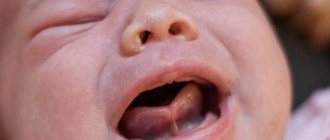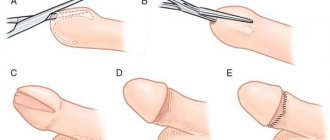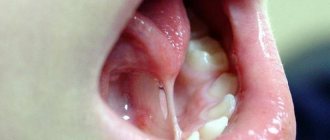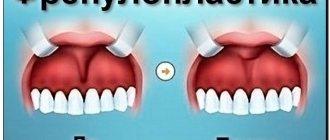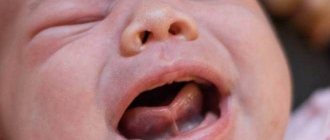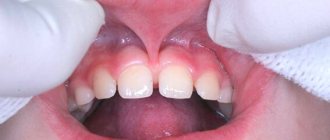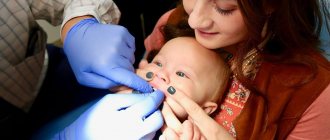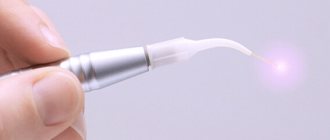Many people have heard about such an operation as cutting the frenulum under the tongue in children, but not everyone understands why and when it is necessary. The problem with the imperfect structure of the hyoid frenulum can appear at different ages
, and parents really need to pay due attention to this. Despite the fact that this part of the body seems very insignificant, it is associated with the process of eating and speech production. Its anomaly can indirectly affect vital phenomena in the body.
The essence of the problem
Photo: this is what a normal frenulum looks like in a child’s mouth
The tongue is attached to the base of the mouth by its root part. Between the tongue and the lower edge of the mouth there is a small fold of skin - the frenulum. Normally, it should be such a length that a person can easily move his tongue, stick it slightly beyond the lips, touch the front surface of the teeth, and pronounce sounds.
A shortened frenulum of the tongue greatly limits its mobility, speech capabilities and ability to eat normally.
, especially in children. The same problems arise if it is not attached correctly, when it is in close proximity to the tip of the tongue.
The consequences are:
- Photo: this is what an incorrectly positioned frenulum looks like
During the period of breastfeeding, the baby is unable to suckle normally, as the tongue is limited in its movements. Because of this, children become very anxious, cry, and lose weight.
- Lack of nutrition can have a negative impact on any developing system of the body, causing stomach diseases.
- A child with a short frenulum develops an incorrect bite, which causes dental diseases and their displacement.
- After teething, when trying to stick out the tip of the tongue, the baby will injure it on the lower incisors.
- In older children, a short hyoid frenulum complicates the formation of sounds: it is difficult for them to pronounce words, and the process of learning speech is delayed.
- The breathing mechanism changes: the baby gets used to breathing through the mouth. Symptoms of the pathology
The frenulum in newborns normally has a length of about 8 mm
or more, and for five-year-old children it increases to 17. But mothers are not always able to take measurements at home, especially if the baby is very active. And only specialists can understand whether everything is located correctly in the oral cavity.
You can determine whether a child has a short frenulum by some external signs:
- In infants, due to their low ability to suck milk, loud smacking and clicking sounds appear.
- The baby attaches incorrectly to the breast, does not cover the areola with his mouth, so he often bites the nipple, which then becomes inflamed.
- The baby is nervous, arches, twists his arms and legs when feeding, often throws and applies to the breast again. Does not gain weight or even lose it.
- The tip of the tongue may be bifurcated due to shortening of the septum. What a child’s forked tongue looks like with a short frenulum, look at the photo on the right.
- Older children have noticeable speech defects, their voice is nasal and quiet.
- Saliva production increases.
- Apnea attacks are possible.
- Due to insufficient food processing, digestive problems occur.
If parents suspect a problem, they should contact their pediatrician or dentist. But in many cases, the defect is determined by a neonatologist in the maternity hospital.
Causes of the defect
A short frenulum of the tongue in a newborn is a congenital anomaly
, which is formed in the first months of fetal development, when all organs are formed. There are several reasons for its appearance:
- The presence of a hereditary predisposition: if the parents had such a feature, it can be inherited.
- The older the expectant mother, the more likely her child is to develop a short frenulum due to the increased risk of developing anomalies.
- The defect can develop if a woman has an infection during pregnancy or suffers from chronic diseases.
- Severe early toxicosis can lead to a lack of nutrients, which is why the fetal organs do not form correctly.
- Exposure to any teratogenic factors: radiation, toxic substances, drugs that are harmful to the body, alcohol, tobacco and drugs.
- Accidents involving injuries to pregnant women.
Some of these reasons do not depend on the actions of future parents, especially genetic predisposition. Other risk factors should be avoided: a pregnant woman should not work in hazardous work, drink, smoke, self-medicate, or expose herself to the risk of falls when playing sports.
Ways to solve the problem
At the moment, there are several correction methods:
- Trimming the frenulum in children with a scalpel.
- Laser cutting of the frenulum under the tongue.
- Stretching through exercise.
- Removing the defect using massage.
Surgical interventions can be performed in different ways, the main methods are:
- Frenuloplasty is the removal of a flap from the tissue of a defective bridge, which is sutured to the resulting wound to increase the mobility of the tongue. Local anesthesia is required, but the damaged mucous membrane heals very quickly. Used for preschool children.
- Frenulotomy: the length of the frenulum is conventionally divided into three parts, an incision is made between the lower and middle lobes, and the edges of the mucous membrane are sutured. This method is suitable for infants.
- Frenulectomy is the same manipulation, but the frenulum is clamped with instruments. The method is suitable for five-year-old children.
In more modern clinics, trimming is performed using a laser. The dissection is carried out after treatment with an anesthetic: gel, spray. For patients, such cutting is less traumatic, damage to blood vessels is minimal - the laser simultaneously cuts the mucous membrane and causes adhesions of the affected capillaries
.
Tissue regeneration after laser trimming takes place within a few days, and you can return to your normal lifestyle an hour after the procedure. But how long you need to stay in the clinic is decided by the doctor. Complications are less common than after eliminating the defect with a scalpel.
How to correct the anomaly?
There are two ways to give mobility to a “heavy” tongue: stretch the frenulum or trim it.
- Option 1 – stretching – is only suitable for children of conscious age who are already capable of performing special exercises under the guidance of parents and a speech therapist. They need to be done twice a day for several months. As a result, the ligament actually develops and speech therapy problems gradually go away or become less pronounced.
- Option 2 - cutting the frenulum of a newborn - is chosen by parents who want to establish breastfeeding of the child. Here you cannot do without surgery, because stretching is a method that is not suitable for small children.
Often parents do not want any surgical interventions on the child’s body and refuse the operation to trim the frenulum. If you choose according to the principle of “the lesser of two evils”: surgery or refusal of breastfeeding, of course, all the arguments are on the side of cutting.
Optimal age for surgery
Is it worthwhile to manipulate the frenulum under the tongue and at what age is it better to trim it? Such decisions depend on when the anomaly was discovered and what the individual characteristics are. If in the maternity hospital the neonatologist determines that the baby has a defective hyoid frenulum, it is better to trim it immediately.
The baby is not yet so mobile as to interfere with the procedure, and the membrane itself is small, thin and does not contain blood vessels. Thanks to these factors, local anesthesia will be sufficient for the manipulations, and you can calm the baby by applying it to the chest after the operation.
Trimming the frenulum of the tongue in children over 6 months of age is associated with some difficulties. The baby becomes mobile, and parents cannot discipline him with persuasion. Due to careless movements, surgery may not occur correctly, which is why surgery is postponed until the age of five
.
During this period, children talk, the doctor can determine whether there are speech defects, whether the frenulum under the tongue is bothering the child, whether it needs to be trimmed or whether it can be stretched with gymnastics.
If the infant’s tongue frenulum was not cut, and many years later he developed speech defects, breathing and digestive problems, then it needs to be circumcised in adulthood. But the older a person is, the denser his membrane becomes, it becomes overgrown with capillaries and nerve endings - which is why cutting it is much more painful than in the case of a baby. Anesthesia is required to make the incision.
How to reduce the risk of permanent malocclusion?
With teenagers and adults, everything is relatively simple - aligners or braces are placed on the teeth, and the bite is corrected by constant pressure and movement of the roots. With young children, what is needed is not correction as such, but conditions so that the child can continue to develop correctly. To do this, you need to find the cause of the violation and eliminate it. Therefore, the orthodontist will most likely recommend contacting other specialists.
- See a surgeon or orthopedist.
To exclude postural pathologies. If a child already has scoliosis, stoop or vertebral displacement, the disorder can be corrected at the very beginning with the help of massage, exercise therapy and other treatment methods. As with bite problems, this is optimal for successful treatment. The body develops and grows quickly, and correct posture will automatically “tighten” the bite to the correct position.
- See an otolaryngologist.
Chronic inflammatory diseases of the ENT organs or a deviated nasal septum disrupt nasal breathing, especially during sleep. The position of the jaws remains incorrect during sleep, so dental problems begin to worsen.
ENT will help eliminate breathing problems
An integrated approach and attention to the child’s health will help him develop correctly. In this way, bite pathologies can be avoided - so that you don’t have to wear aligners or braces at all.
Other articles:
- Retention period after braces: why is it needed?
- What is right for a teenager – braces or aligners?
Examinations before surgery and contraindications
Any surgical procedure in the oral cavity is a risk to the body. In order to prevent complications after surgery, it is necessary to undergo preliminary examinations prescribed by the doctor. The most significant tests are blood and urine tests, determination of blood coagulation and fluorography.
Contraindications for frenuloplasty are infections of the throat, oral cavity, inflammatory processes in any part of the body
, since pathogenic microorganisms can enter the incision of the mucous membrane. This is why a mandatory examination is carried out before intervention. You cannot operate on patients with cancer or decreased blood clotting.
Postoperative period
The mucous membrane in the mouth is restored quickly. But cutting the frenulum can cause complications:
- Formation of a hard scar at the site where the incision was made.
- The development of the inflammatory process due to infection.
- Temperature increase. It appears as a sign of the development of an infectious process or a peculiar reaction to an operation.
The baby may react to complications with constant anxiety and refusal to eat. Children three years old and older can tell themselves what worries them. If you experience any discomfort, you should consult a doctor; only a specialist will correctly assess the baby’s condition and prescribe the best treatment.
To avoid complications, you need to keep your mouth clean. Five-year-old children already brush their teeth and can rinse their mouths with water. For several days after the defect is removed, you should not chew solid food or talk much.
You should ask your doctor exactly how long the restrictions should be observed. After a follow-up examination, the attending doctor will recommend special exercises to develop the elasticity of the frenulum.
Correction using gymnastics for the tongue
Only a doctor can determine whether it is worth performing surgery on a child’s short frenulum of the tongue or whether it is better to remove the defect with the help of exercises. Therefore, even if parents are not inclined to undergo surgery, they still need to go to a pediatrician or dentist for consultation and surgery or correct individual selection of exercises.
The opportunity to conduct gymnastic classes appears when the baby can already repeat some given actions. But there are simple exercises even for newborns: they are given a silver spoon to lick, milk is dripped onto their upper lip, which makes them try to lick it, and at a slightly older age they are smeared with jam.
When the baby is able to understand the mother’s requests to repeat certain actions, you can do more complex gymnastics:
- Close your mouth and feel the side walls of your tongue, palate and lower part of your mouth.
- Open your mouth and reach as far as possible to the outer surface of your lips.
- Click your tongue.
- Place the tongue on your lower lip and hold it in this position for 10 seconds.
- Stick your tongue out as far as possible and hold for 10 seconds. You can also ask the baby in a playful way to show how long his tongue is.
Short frenulum of the tongue - what is it?
But let's look at the problem in more detail. So, short frenulum of the tongue - what is it? The bridge connecting the tongue to the palate, or simply a special ligament if not long enough, significantly reduces the mobility of the tongue. It would seem that this is a trifle. However, children with this problem very clearly suffer from inconvenience. Moreover, it gets worse with age. When baby teeth are replaced by permanent ones, a short frenulum will not allow the dentition to form correctly, which almost always carries a high risk of caries, gum disease and other unpleasant problems.
There are 5 different types of pathology, each of which brings specific discomfort to the child’s life:
- thin and transparent - limits the mobility of the tongue;
- thin and translucent - causes a semblance of bifurcation of the tip of the tongue when directed upward;
- thick - limits the mobility of the tongue;
- dense and very short, combined with the muscles of the tongue - along with cleft lips and palate;
- dense and very short, combined with the muscles of the tongue, severely limits the mobility of the tongue.
The next question naturally arises: who to turn to? If the baby is unable to stick out his tongue or reach his upper teeth, we can conclude that there is a possibility of pathology. However, the final verdict must be made by a professional. The specialist who will make the appropriate diagnosis must conduct an examination of the oral cavity. Most often this is a dentist, but doctors of other specializations can also evaluate the elasticity and length of the frenulum, the normal value of which is 8 mm for 5 years of age.
Most often, a short frenulum is a congenital pathology, including hereditary. The cause of the defect in the child can be viral diseases, stress, toxicosis or other factors during the mother’s pregnancy. It is important to understand that even in the absence of obvious discomfort, trimming is necessary to eliminate the risk of problems in the future.
How to fix the problem and who to contact? The decision on the length of the tongue frenulum is made by parents during a consultation with a dentist. The defect can be eliminated surgically or with the help of special gymnastic exercises for articulation.
The method of eliminating the defect is selected by the dentist individually depending on parameters such as the degree of shortening, the presence of consequences, localization, and the age of the child.
Which method is suitable in your case depends on the surrounding circumstances. So, if a short frenulum is discovered in the first days of a child’s life and directly affects his nutrition, surgery on the frenulum of the tongue is necessary, which is often performed right in the maternity hospital. Please note that for newborns the process will be completely painless! It is also worth operating if an incorrect bite is formed or has formed. After frenuloplasty, the child will experience some discomfort associated with a change in diction. This is a temporary phenomenon that can be easily eliminated by classes with a speech therapist and special gymnastics for the tongue.
If a child has a burr, speech therapy disorders associated with pronunciation and speech can be corrected by performing a set of exercises to develop and stretch the frenulum.
Torn frenulum
In some children, an unfortunate fall causes a rupture of the frenulum of the tongue. This injury can occur due to close contact of the septum with the lower teeth.
. If a child cuts the frenulum, he may experience bleeding and swelling in the oral cavity, and it becomes painful for the baby to chew and talk.
You cannot rely on self-medication; you should immediately consult a doctor. Sometimes it is necessary to stitch up the resulting wound due to the risk of excessive bleeding.
The importance of such a part of the body as the frenulum cannot be underestimated. There are many ways to lengthen the small septum to free up the tongue for free speech and eating. Before taking certain measures, it is necessary to consult with a specialist and do preoperative tests if it is necessary to trim the frenulum.
If the anomaly causes organ dysfunction, then frenuloplasty is necessary, and it is best to perform it at the age recommended by the doctor. Ignoring such a problem means exposing the child to the risk of frequent respiratory and digestive diseases, and problems in pronunciation of sounds.
Who undergoes upper lip frenuloplasty?
Most dental patients who undergo this type of surgery are children, since a thick or short frenulum can cause various serious complications:
- The presence of a diastema (gap) between the central incisors. Weaving into the interdental papilla, the frenulum of the upper lip forms a thick cord that prevents the possibility of convergence towards the center of the incisors. The diastema increases with constant load, and teeth shift from the center and forward. In this case, constant trauma to the interdental papilla occurs, which contributes to the development of periodontitis and tooth loss.
- In preparation for treatment with an orthodontist. Various soft tissue cords in the oral cavity, including the frenulum of the tongue and upper lip, can create a slight load on the dentition, and this has a significant impact on the bite. If you need to correct your bite, be sure to pay attention to the frenulum in the mouth.
- For periodontal diseases and the threat of their development. In this situation, the frenulum of the upper lip pulls the mucous membrane from the teeth. Gum recession develops - an unpleasant phenomenon that requires expensive and lengthy treatment.
- In preparation for removable prosthetics. A short frenulum of the tongue when moving the lips (for example, when eating or talking) can contribute to the removal of removable dentures. This is true for those patients who use them.
- In some cases, a severely shortened frenulum can provoke speech therapy problems by disrupting sound production. Therefore, in this case, plastic surgery of the upper lip is also indicated.
- In infants - difficulty sucking the breast, increased duration of feeding, insufficient weight gain.
- The occurrence of malocclusion ─ with a shortened frenulum, the front incisors move forward. Therefore, if surgery is not performed in time, subsequent treatment will be expensive and difficult.
- A gradual increase in tooth instability, exposure of their roots and increased sensitivity.
- The formation of a gum pocket is a depression between the gum and tooth, which ultimately leads to plaque and periodontitis.
Optimal age for upper frenulum correction
How urgently such an operation needs to be performed depends on the severity of the pathology and its strength of influence on the child’s health. For children, there are two favorable periods for plastic surgery of the upper frenulum. One of them is the age of 2.5-6 months, which will simplify the problem of feeding because the child will not lose the nipple, which happens with a short frenulum. In the old days, such an operation was not performed at such an early age, but with the advent of new techniques and modern medical equipment, such an intervention is now quite safe, and infants tolerate it well. This operation should only be performed by a pediatric dentist-surgeon.
The second favorable period for frenulum correction is the age of 6-9 years. At this age, four front incisors have already erupted on the lower and upper dental arches. There is an active change in the bite - baby teeth fall out and permanent teeth erupt. It is ideal when the central incisors are erupting and there are no lateral incisors yet. In such a situation, the lateral incisors, which are erupting, push the central ones towards the center (now nothing can interfere with their movement). And then everything will return to normal - on its own or with orthodontic support.
Due to certain physiological differences, plastic surgery of the lower lip is performed at the age of 7-9 years, of the upper lip - at 6-8 years. If pediatricians overlooked the pathology in childhood, the need for plastic surgery of the upper lip frenulum also arises in adulthood. There is no danger in this, since adults can undergo such an operation just as easily as children.

